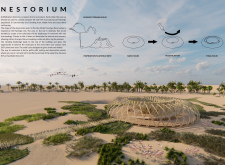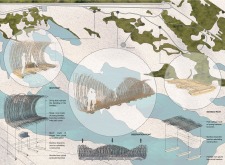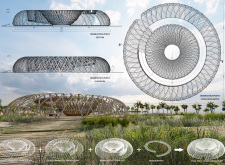5 key facts about this project
The primary function of the NESTORIUM is to provide a structured yet unobtrusive vantage point for visitors to observe flamingos in their natural habitat. The architecture is characterized by its circular form and elongated pathways that guide visitors through native vegetation while offering strategic views. The design reflects an understanding of wildlife behavior, ensuring that the experience remains enriching for both humans and animals.
In terms of construction, the use of glued laminated timber for the structural framework allows for both aesthetic and functional versatility. This material is lightweight yet robust, allowing for curved and organic forms that mimic the natural nests of flamingos. The integration of bamboo in walkways and shading devices further emphasizes the commitment to sustainability. Such design choices not only provide a cohesive visual experience but also enhance the structure's durability.
Biomimetic design elements distinguish the NESTORIUM from conventional observation platforms. The soft, nest-like shape minimizes visual impact on the environment, promoting a sense of immersion in nature. Additionally, the structure is strategically elevated, allowing visitors to gain broader perspectives while maintaining a low profile in relation to the surrounding landscape. This consideration ensures that the wildlife is minimally disturbed, thereby fostering a more authentic observation experience.
The NESTORIUM exemplifies a thoughtful approach to architecture that aligns with ecological principles. By blending innovative design with a commitment to sustainability, it creates a harmonious dialogue between human interaction and natural ecosystems. Visitors are encouraged to explore the project presentation for further insights into the architectural plans, sections, and overall ideas that guided the design process.


























